| Maat-ka-Ra Hatshepsut |
| update: 27.04.2009 |
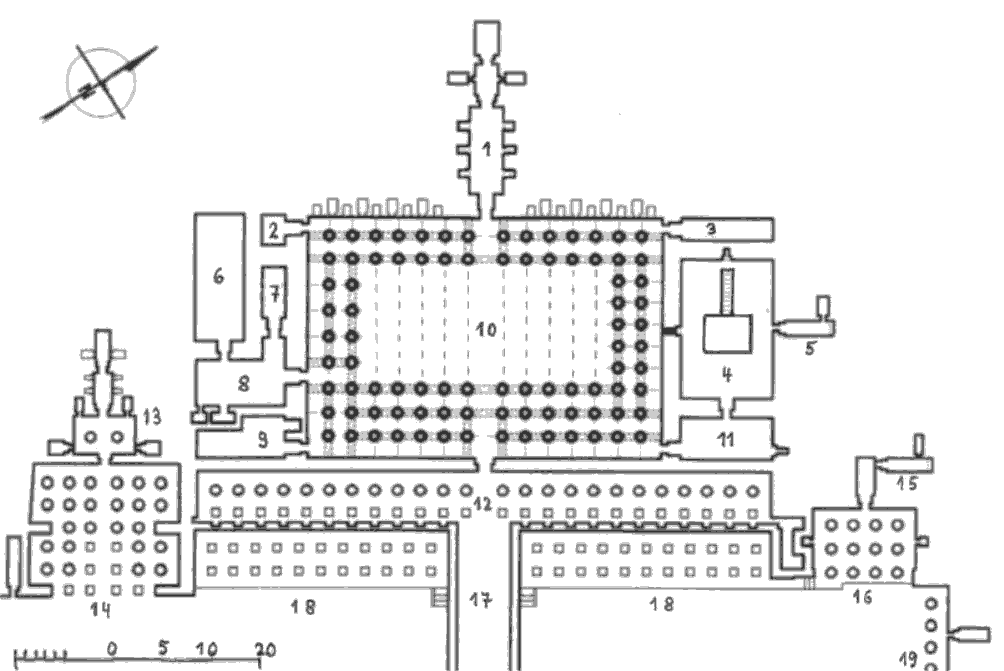
| 1 | Main Sanctuary of Amun-Re |
| 2 | northern Chapel of Amun-Re |
| 3 | southern Chapel of Amun-Re |
| 4 | Sun Altar |
| 5 | Upper Chapel of Anubis |
| 6 | Chapel of Hatshepsut |
| 7 | Chapel of Thutmosis I |
| 8 | Vestibule |
| 9 | Chamber with Window |
| 10 | upper Court |
| 11 | Vestibule in front of the Sun Altar |
| 12 | 3. Portico |
| 13 | Chapel of Hathor |
| 14 | Portico in front of the Chapel of Hathor |
| 15 | lower Chapel of Anubis |
| 16 | Portico in front of the Lower Chapel of Anubis |
| 17 | 2nd ramp |
| 18 | 2nd Portico (with the Hall of Punt on the left and the Hall of Birth on the right side of the ramp) |
| 19 | northern colonnade |
| floor plan according to: Szafrańskj (ed.) "Queen Hatshepsut and her Temple 3500 years later", Warsaw University Polish Center of Mediterranean Archeology in Cairo, 2001 |
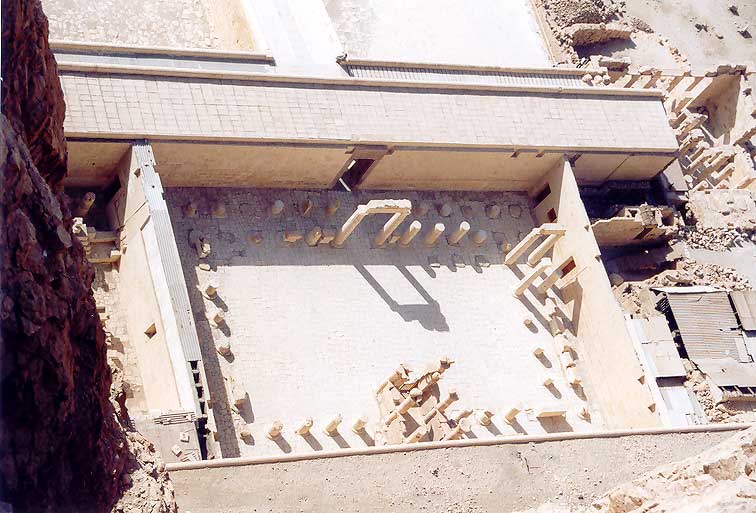
|
The photo above shows the upper terrace seen from the rock cliff
above. In comparison with the ground plan the photo is turned
clockwise by 180° (the photo is a gift of Anke
and Ralf Klein, 2003).
At the left side a part of the Sun Altar with its vestibule (please note the column in the corner) is shown. Next to the right the photo shows the upper courtyard with the remains of its columns, the granite gate leading to the 3rd portico (above) and the entrance to the main sanctuary with its columns and intercolumnar walls. At the right side - from top to bottom - the following rooms are shown: the room with the window, the vestibule in front of the chapels of Hatshepsut und Thutmosis I. Behind the chapel of Thutmosis I lies the southern Chapel of Amun-Ra. In the right upper corner of the photo shows the columns of the portico of the Chapel of Hathor (2nd portico). |
| 3rd Portico |
| The crown of the facade was the 3rd portico especially with the 26 statues of Hatshepsut erected against the pillars and the eastern ends of the lateral walls. The photo below shows the 3rd portico and some of the Osiride statues seen from its south-east corner. |
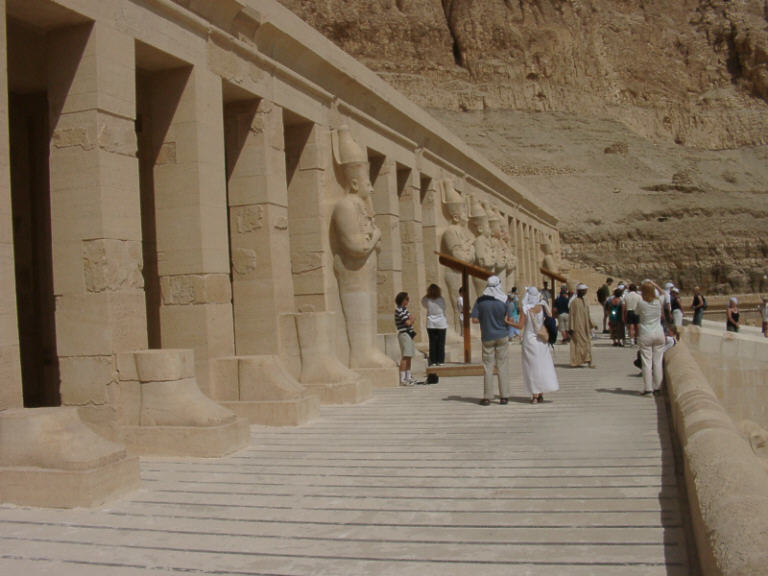
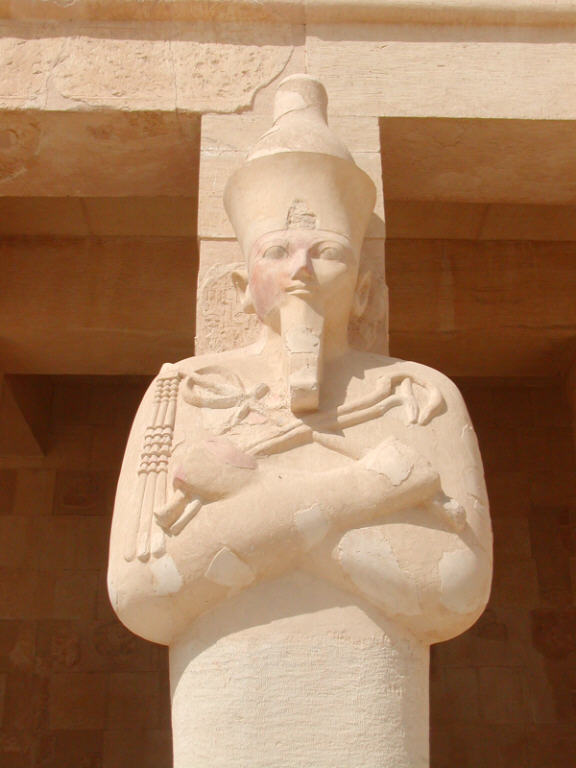 |
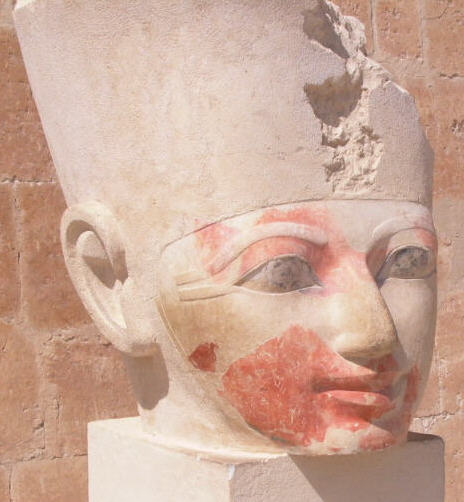 |
| The more than 5 ms high (Pawlicki, 1999; with base about 5.20 m according to the plan presented in Arnold, 2004) osiride statues are very similar two the colossal statues erected in front of the 1st portico but they hold the attributes of the royal authority (divine power and life) in the hands and crossed over the chest. The lower part of the body is wrapped in a shroud, the upper part in kind of robe which is used in the jubilee festival. Only the hands carrying the symbols of royal authority can be seen from under the robe. All statues are crowned with the Double Crown. Many statues of Hatshepsut which had been erected on the 3rd portico were destroyed after her death, only a few heads have survived. |
| Starting on the north (right) side the west wall of the 3rd portico was decorated with 110 columns of text describing miraculous "events" which took place before the accession of Hatshepsut . All of these "events" repeatedly expressed the will of Amun-Ra that his daughter should be crowned to king of the Two Lands. After the death of Hatshepsut the columns were replaced by Thutmosis III with figural scenes. The scenes repeat in different from the coronation of Hatshepsut that had been already presented in the northern (right) wing of the 2nd portico. The fact that Thutmosis III got depicted together with the queen lends in some way legitimacy to the unusual accession of Hatshepsut to the throne. |
| The southern and northern sidewalls show both a ritual run of the king. The heavily destroyed scene on the southern sidewall shows the "Seizing the Oar" but the god cannot be identified anymore. |
| The northern sidewall shows Thutmosis II (Aa-cheper-en-Ra) performing a ritual run (next photo) before the ithyphallic Amun (next but one photo). |
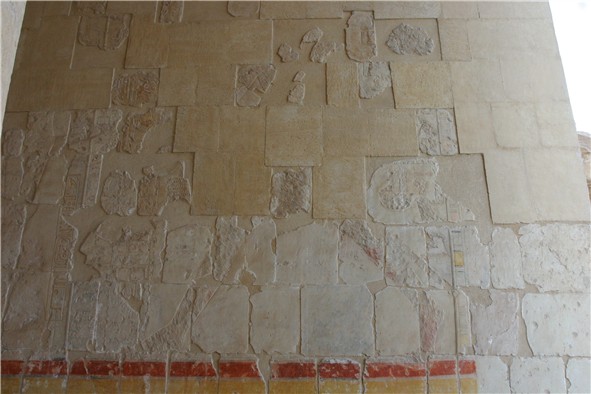
|
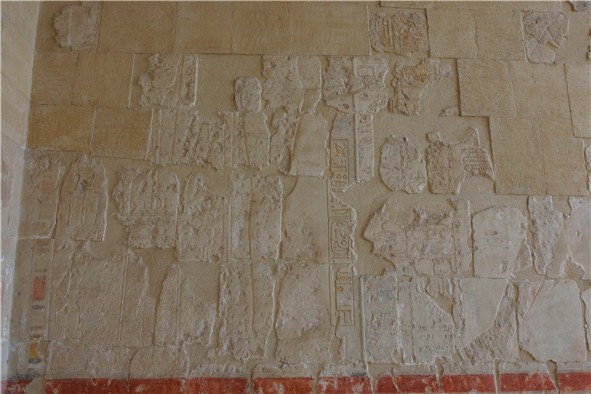 |
| The few remaining blocks of the southern sidewall show that there the king was depicted in another ritual run called "Seizing the oar." The green arrows point to the leg, the read arrow to the end of the oar. |
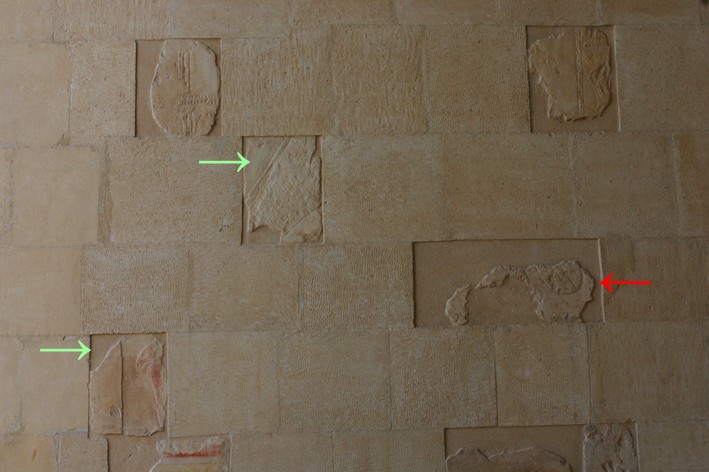
| The western wall was largely changed after the death of Hatshepsut and the devastations by the iconoclasts of the Amarna period. The decoration now starts with the enthronement of Thutmosis I and the figures of Hatshepsut were replaced by images of her royal consort, Thutmosis II. Two restoration texts of Horemheb and Ramses II talk of restoring the temple for "the father of fathers Thutmosis III". |
| All chapels on the upper terrace (Main Sanctuary of Amun-Ra, southern Chapel of Amun-Ra, northern Chapel of Amun-Ra, Upper Chapel of Anubis, Cult Chapels of Hatshepsut and Thutmosis I, the Sun Altar) are closed for the public. Therefore, I could not take own photos of several chapels (e.g. the upper Chapel of Anubis). |
|
Upper Chapel of Anubis |
| Djeser djeseru | Location of the Monument | History | Djeser djeseru - the times after |